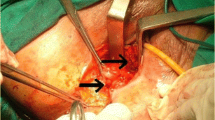Abstract
Hospital and office charts of patients who underwent vaginal cuff scar excision for vesicovaginal fistula (VVF) repair from February 1998 to December 2002 at our institution were reviewed. Preoperative demographics and fistula characteristics were gathered. Intraoperative data included use of tissue flaps, blood loss, OR time and anesthetic type. Postoperative review included time to discharge, successful repair and postoperative urinary or sexual dysfunction. Forty fistula repairs were identified. Ninety-three percent occurred after a hysterectomy and no subjects had a history of radiation. Forty-two percent had failed at least one surgical repair of their fistula and 12% had failed two or more attempted repairs. Twenty percent of the fistulae measured 1 cm or more in diameter and the remaining 80% were 5 mm or less. Peritoneal flaps and martius flaps were performed in 32% and 5%, respectively. Postoperatively, 100% of subjects were evaluated at 3 weeks when the suprapubic catheter was removed and 93% were evaluated at 3 months or later. All subjects were cured of their fistulae at last contact. At 3 months postoperatively, 94% percent denied any urinary dysfunction and 85% had resumed sexual intercourse. Two sexually active subjects reported mild deep dyspareunia. Transvaginal cuff scar excision is an effective method for the primary and secondary repair of vesicovaginal fistulae and does not appear to cause postoperative irritative voiding symptoms or dyspareunia.
Similar content being viewed by others
References
Arrowsmith SD (1994) Genitourinary reconstruction in obstetric fistulas. J Urol 152:403–406
Iselin CE, Aslan P, Webster GD (1998) Transvaginal repair of vesicovaginal fistulas after hysterectomy by vaginal cuff excision. J Urol 160:728–730
Smith GL, Williams G (1999) Vesicovaginal fistula. Br J Urol Int 83:564–570
Thomas K, Williams G (2000) Medicolegal aspects of vesicovaginal fistulae. Br J Urol Int 86:354–359
Eilber KS, Kavaler E, Rodreuez LV, Rosenblum N, Raz, S (2003) Ten-year experience with transvaginal vesicovaginal fistula repair using tissue interposition. J Urol 169(3):1033–1036
Flores-Carreras O, Cabrera JR, Galeano PA, Torres FE (2001) Fistulas of the urinary tract in gynecologic and obstetric surgery. Int Urogynecol J 12:203–214
Ayhan A, Tuncer L, Dogan L, Pekin S, Kisnisci (1995) Results of treatment in 182 consecutive patients with genital fistulas. Int J Obstet Gynecol 48:43–47
Amundsen CL, Guralnick ML, Webster GD (2001) Functional success of vaginal-cuff excision as a technique for transvaginal repair of vesicovaginal fistulae after hysterectomy. J Pelv Surg 7:15–18
Flynn MK, Amundsen CL (2004) Delayed presentation and successful repair of a recurrent vesicovaginal fistula after hysterectomy and primary abdominal repair. Int Urogynecol J Pelvic Floor Dysfunct 15:53–55
Lee RA, Symmonds RE, Williams TJ (1988) Current status of urinary fistula. Obstet Gynecol 72:313–319
Hilton P (1998) Urodynamic findings in patients with urogenital fistulae. Brit J Urol 81:539–542
Scheicher DJ, Ojengede OHA, Elkins TE (1993) Urologic evaluation after closure of vesicovaginal fistulas. Int Urogynecol J 4:262–265
Uebersax JC, Wynman JF, Shumaker SA, McClish DK, Fantl J (1995) Short forms to assess life quality and symptom distress for urinary incontinence in women: the Incontinence Impact Questionnaire and the urogenital distress inventory. Neurourol Urodyn 14:131–139
Rogers RG, Coates KW, Kammere-Doak D, Khalsa S, Qualls C (2003) A short form of the pelvic organ prolapse/urinary incontinence sexual questionnaire (PISQ-12). Int Urogynecol J 14:164–168
Tancer ML (1992) Observations on prevention and management of vesicovaginal fistula after total hysterectomy. Surg Gynecol Obstet 175:501–506
Mathevet P, Valencia P, Cousin C, Mellier G, Dargent D (2001) Operative injuries during vaginal hysterectomy. Eur J Obstet Gynecol Reprod Biol 97:71–75
Cogan SL, Paraiso MFR, Bedaiwy MA (2002) Formation of vesicovaginal fistulas in laparoscopic hysterectomy with electrosurgically induced cystotomy in female mongrel dogs. Am J Obstet Gynecol 187:1510–1514
Meeks GR, Sams JO, Field KW, Fulp W, Margolis MT(1997) Formation of vesicovaginal fistula: the role of suture placement into the bladder during closure of the vaginal cuff after transabdominal hysterectomy. Am J Obstet Gynecol 177:1298–1304
Author information
Authors and Affiliations
Corresponding author
Additional information
Disclaimer: The views expressed in this article are those of the authors and do not reflect the official policy or position of the United States Army, Department of Defense or the United States government
This article was presented at the 24th annual meeting of the American Urogynecologic Society, September 11–13, 2003. Hollywood, FL, USA
Editorial Comment: Vesicovaginal fistula (VVF) is a most distressing problem for both the patient and surgeon alike. The most expeditious, safest, and least morbid repair with the greatest likelihood of success should be employed. These authors have previously described this approach for VVF repair and, now, in this article have published on functional outcomes. There is very little in the literature on long-term functional outcomes following VVF repair and therefore this represents an important contribution. Although the use of anonymous, complete validated questionnaires as an outcome measure would have been ideal, especially as regards urinary and sexual function, these authors report that functional outcomes following vaginal cuff excision repair of VVF are satisfactory. It is important to remember that the vast majority of patients presenting with VVF were healthy, presumably without significant urinary or sexual dysfunction, and underwent an elective surgery which created the problem. This paper suggests that these patients can be restored to a satisfactory level of urinary and sexual function following repair.
Rights and permissions
About this article
Cite this article
Flynn, M.K., Peterson, A.C., Amundsen, C.L. et al. Functional outcomes of primary and secondary repairs of vesicovaginal fistulae via vaginal cuff scar excision. Int Urogynecol J 15, 394–398 (2004). https://doi.org/10.1007/s00192-004-1188-y
Received:
Accepted:
Published:
Issue Date:
DOI: https://doi.org/10.1007/s00192-004-1188-y




